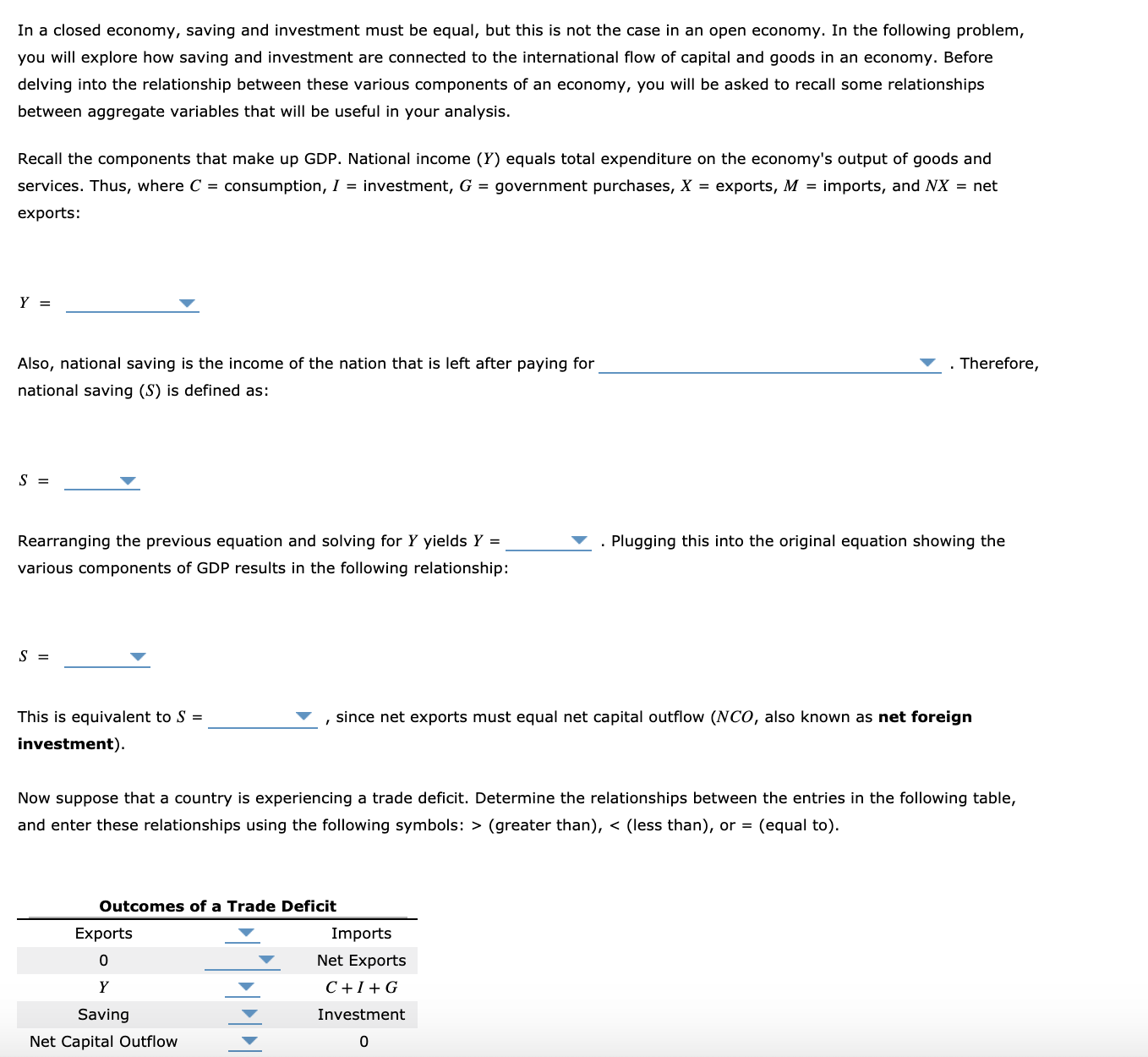In a closed economy, saving and investment must be equal, but this is not the case in an open economy. In the following problem, you will explore how saving and investment are connected to the international flow of capital and goods in an economy. Before delving into the relationship between these various components of an economy, you will be asked to recall some relationships between aggregate variables that will be useful in your analysis. Recall the components that make up GDP. National income (Y) equals total expenditure on the economy's output of goods and services. Thus, where C = consumption, I = investment, G = government purchases, X = exports, M = imports, and NX = net exports: Y = Also, national saving is the income of the nation that is left after paying for Therefore, national saving (S) is defined as: Rearranging the previous equation and solving for Y yields Y = . Plugging this into the original equation showing the various components of GDP results in the following relationship: This is equivalent to S = since net exports must equal net capital outflow (NC0, also known as net foreign investment). Now suppose that a country is experiencing a trade deficit. Determine the relationships between the entries in the following table, and enter these relationships using the following symbols: > (greater than), < (less than), or = (equal to). Outcomes of a Trade Deficit Exports Imports Net Exports C+I+ G Saving Investment Net Capital Outflow
In a closed economy, saving and investment must be equal, but this is not the case in an open economy. In the following problem, you will explore how saving and investment are connected to the international flow of capital and goods in an economy. Before delving into the relationship between these various components of an economy, you will be asked to recall some relationships between aggregate variables that will be useful in your analysis. Recall the components that make up GDP. National income (Y) equals total expenditure on the economy's output of goods and services. Thus, where C = consumption, I = investment, G = government purchases, X = exports, M = imports, and NX = net exports: Y = Also, national saving is the income of the nation that is left after paying for Therefore, national saving (S) is defined as: Rearranging the previous equation and solving for Y yields Y = . Plugging this into the original equation showing the various components of GDP results in the following relationship: This is equivalent to S = since net exports must equal net capital outflow (NC0, also known as net foreign investment). Now suppose that a country is experiencing a trade deficit. Determine the relationships between the entries in the following table, and enter these relationships using the following symbols: > (greater than), < (less than), or = (equal to). Outcomes of a Trade Deficit Exports Imports Net Exports C+I+ G Saving Investment Net Capital Outflow
Chapter19: Measuring Economic Performance
Section: Chapter Questions
Problem 6P
Related questions
Question

Transcribed Image Text:In a closed economy, saving and investment must be equal, but this is not the case in an open economy. In the following problem,
you will explore how saving and investment are connected to the international flow of capital and goods in an economy. Before
delving into the relationship between these various components of an economy, you will be asked to recall some relationships
between aggregate variables that will be useful in your analysis.
Recall the components that make up GDP. National income (Y) equals total expenditure on the economy's output of goods and
services. Thus, where C = consumption, I = investment, G = government purchases, X = exports, M = imports, and NX = net
exports:
Y =
Also, national saving is the income of the nation that is left after paying for
Therefore,
national saving (S) is defined as:
Rearranging the previous equation and solving for Y yields Y =
. Plugging this into the original equation showing the
various components of GDP results in the following relationship:
This is equivalent to S =
since net exports must equal net capital outflow (NC0, also known as net foreign
investment).
Now suppose that a country is experiencing a trade deficit. Determine the relationships between the entries in the following table,
and enter these relationships using the following symbols: > (greater than), < (less than), or = (equal to).
Outcomes of a Trade Deficit
Exports
Imports
Net Exports
C+I+ G
Saving
Investment
Net Capital Outflow
Expert Solution
This question has been solved!
Explore an expertly crafted, step-by-step solution for a thorough understanding of key concepts.
This is a popular solution!
Trending now
This is a popular solution!
Step by step
Solved in 2 steps

Recommended textbooks for you

Exploring Economics
Economics
ISBN:
9781544336329
Author:
Robert L. Sexton
Publisher:
SAGE Publications, Inc

Economics (MindTap Course List)
Economics
ISBN:
9781337617383
Author:
Roger A. Arnold
Publisher:
Cengage Learning


Exploring Economics
Economics
ISBN:
9781544336329
Author:
Robert L. Sexton
Publisher:
SAGE Publications, Inc

Economics (MindTap Course List)
Economics
ISBN:
9781337617383
Author:
Roger A. Arnold
Publisher:
Cengage Learning
